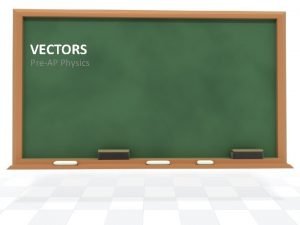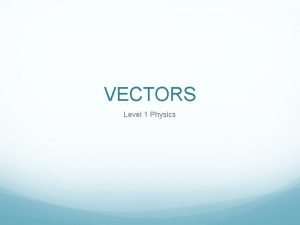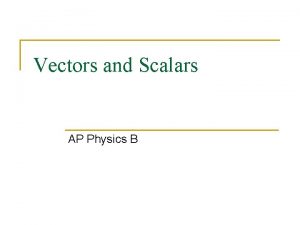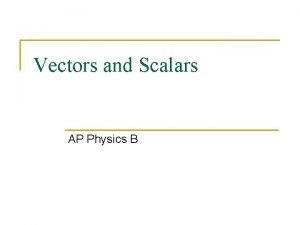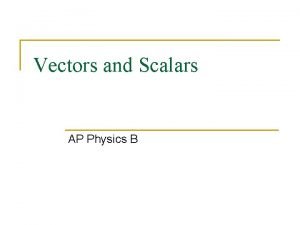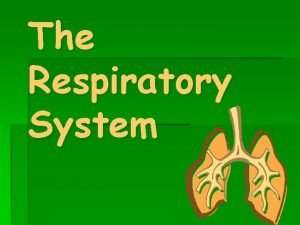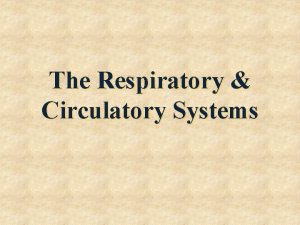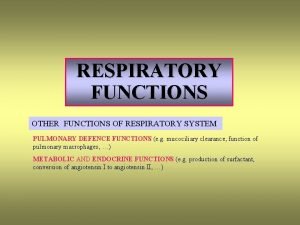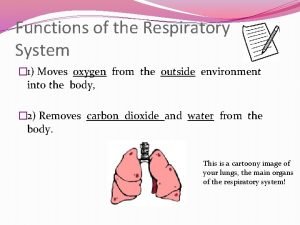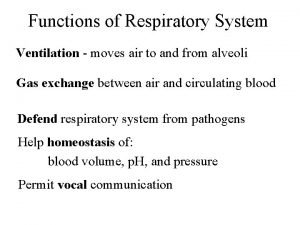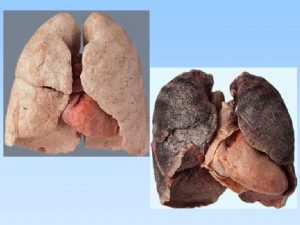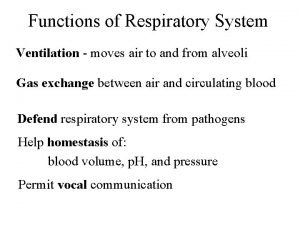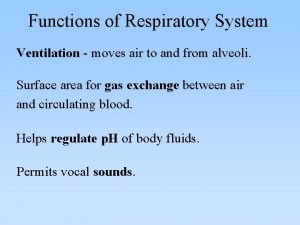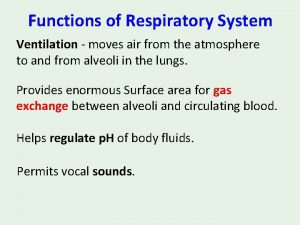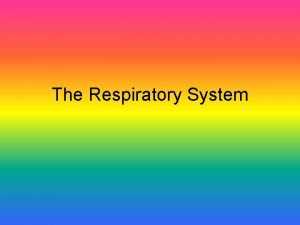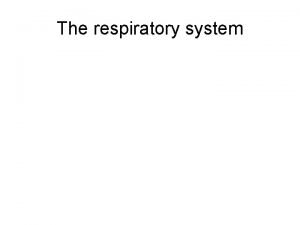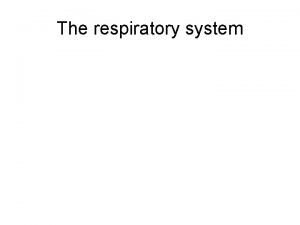The Respiratory System Functions The respiratory system moves

























- Slides: 25

The Respiratory System

Functions • The respiratory system moves oxygen from the outside environment into the body. • It also removes carbon dioxide and water from the body.

Organs • Air travels in and out of the organs of the respiratory system; – nose – pharynx – larynx – trachea – bronchi – lungs • bronchioles • alveoli


vocabulary word! • respiration – the transport of oxygen from outside the body to cells and tissues, and the transport of carbon dioxide and wastes away from cells and to the environment.

vocabulary word! Why do we Breathe? • cellular respiration - (break down of glucose for energy) requires oxygen as a reactant. • Respiration also produces water and carbon dioxide which can leave the body through the lungs

The Air You Breathe • The air you breathe comes from the atmosphere – 21% oxygen – 78% nitrogen – 1% other gases • Your body does not use most of the air you inhale • What you don’t need is exhaled

The Path of Air • As air moves through the organs, it is warmed, moistened, and bacteria and other small particles are removed.

In the nose … • Air is warmed • Nose hair filters dust and other small things out. • Mucus also traps small particles, dust, and bacteria.


the pharynx vocabulary word! • pharynx - (throat) is a long hollow tube that connects the nose to the trachea.

vocabulary word! the larynx • larynx – part of the throat where the vocal cords are located.

vocabulary word! the trachea • trachea - connects the pharynx to the bronchi. It is lined with mucus and small hairs that trap particles. • You can feel the ridges of the trachea by running your finger down your neck

vocabulary word! bronchi • bronchi - passages that direct air into the lungs. – Left bronchus goes to the left lung – Right bronchus goes into the right lung

vocabulary word! the lungs • lungs - The main organs of the respiratory system that provide oxygen to the body. • The bronchi, bronchioles, and alveoli are all inside the lungs.


vocabulary word! bronchioles • bronchioles - smaller branches that come off of the bronchi.

vocabulary word! alveoli • alveoli - smallest structure in the lungs where gas exchange takes place between the lungs and the blood. • The walls of the alveoli are very thin which allows the gases to diffuse back and forth.


Gas Exchange • After air enters the alveoli, oxygen passes through the wall of the alveoli, into the capillary that surrounds it , then into the artery headed to the heart. • At the same time, carbon dioxide and water pass from the vein into the capillary, then into the alveoli where they are exhaled.

Gas Exchange alveoli

vocabulary word! • diaphragm – dome-shaped muscle below the lungs that causes us to inhale and exhale.

How You Breathe • You breathe on average 20, 000 times a day • Breathing speeds up when you exercise • Breathing slows down when you are asleep • Both involuntary and voluntary muscles and nervous system helps you breathe

Speaking • Inside your trachea are vocal cords • Vocal cords stretch across the opening • Your vocal cords work like the neck of a balloon when it is stretched • Air passes over the vocal cords, making them vibrate which produces sound – Low – vocal cords contract & shorten – High – vocal cords relax & lengthen

Body systems that work with the respiratory system; • muscular system to pull air into the lungs • circulatory system to carry the oxygen in and carbon dioxide out • digestive system to provide energy
 Conducting zone of the respiratory system
Conducting zone of the respiratory system Upper respiratory system labeled
Upper respiratory system labeled Digestive respiratory and circulatory system
Digestive respiratory and circulatory system A storm system moves 5000 km due east
A storm system moves 5000 km due east A storm system moves 5000 km due east
A storm system moves 5000 km due east Carl yaztremski
Carl yaztremski Vectors and scalars in physics
Vectors and scalars in physics A storm system moves 5000 km due east
A storm system moves 5000 km due east Ap physics vector problems
Ap physics vector problems Tiny air sacs at the end of the bronchioles
Tiny air sacs at the end of the bronchioles Circulatory system and respiratory system work together
Circulatory system and respiratory system work together Absolute value function to piecewise function
Absolute value function to piecewise function How to solve evaluating functions
How to solve evaluating functions Evaluating functions and operations on functions
Evaluating functions and operations on functions Hình ảnh bộ gõ cơ thể búng tay
Hình ảnh bộ gõ cơ thể búng tay Slidetodoc
Slidetodoc Bổ thể
Bổ thể Tỉ lệ cơ thể trẻ em
Tỉ lệ cơ thể trẻ em Gấu đi như thế nào
Gấu đi như thế nào Tư thế worms-breton
Tư thế worms-breton Hát lên người ơi
Hát lên người ơi Các môn thể thao bắt đầu bằng tiếng chạy
Các môn thể thao bắt đầu bằng tiếng chạy Thế nào là hệ số cao nhất
Thế nào là hệ số cao nhất Các châu lục và đại dương trên thế giới
Các châu lục và đại dương trên thế giới Công thức tính thế năng
Công thức tính thế năng Trời xanh đây là của chúng ta thể thơ
Trời xanh đây là của chúng ta thể thơ



